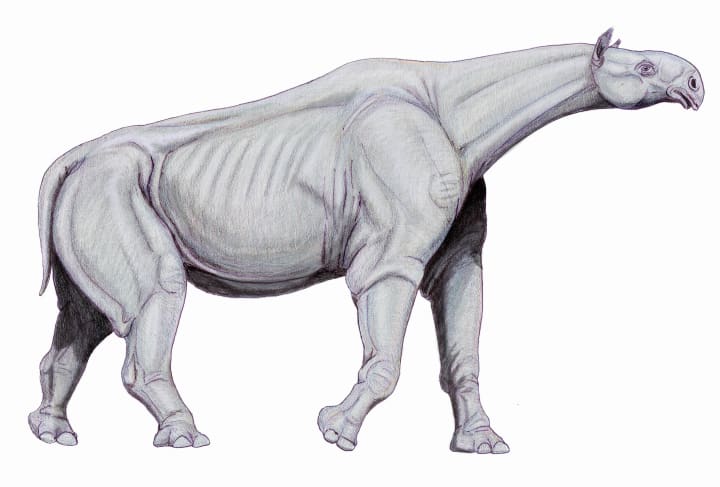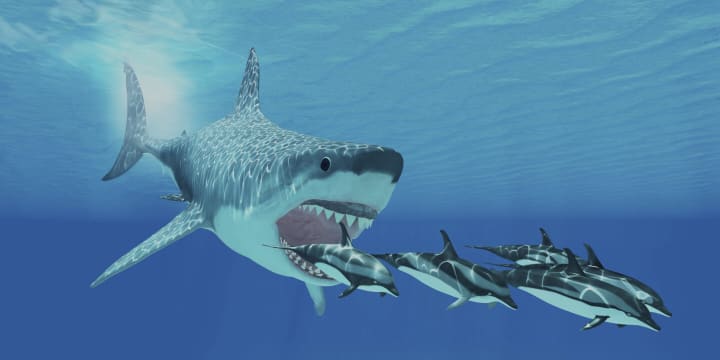Welcome to today's article where we'll explore some of the largest creatures that have ever existed. Let's begin our journey through prehistoric and modern times.
Number 10: The Indricotherium
The Indricotherium, also known as Paraceratherium, is a creature that remains shrouded in controversy among paleontologists. Discovered in the early 20th century, this enormous mammal holds the title of the largest terrestrial mammal to have ever walked the Earth. With its massive size, the bones of the Indricotherium could easily be mistaken for those of the largest dinosaurs. Despite its resemblance to sauropod dinosaurs, the Indricotherium was actually an ancestor of modern rhinoceroses. Its appearance was a unique blend of a rhino, elephant, and Brontosaurus. The creature boasted a long neck similar to diplodocus or Brachiosaurus, while its legs were thin and it had three-toed feet, reminiscent of giant elephant feet. As an herbivore, the Indricotherium used its prehensile upper lip to grab leaves from trees. While its exact size is uncertain due to limited fossil records, it is estimated to have been around 40 feet long and weighing approximately 20 tons. These magnificent creatures roamed the plains of Asia for a brief period during the Oligocene period, between 33 and 23 million years ago.

Number 9: The Spinosaurus
The Spinosaurus takes the title of the largest carnivorous dinosaur known to paleontologists. This colossal creature measured around 50 feet in length and weighed roughly seven and a half tons. First discovered in Western Egypt in 1910, the Spinosaurus continues to fascinate researchers, who are still unraveling its mysteries. The debate about its lifestyle continues, as scientists speculate whether it was semi-aquatic or fully terrestrial. Given its presence in coastal areas and its long snout, it is believed that the Spinosaurus primarily fed on seafood. However, the extent of its aquatic abilities remains unclear. Living in North Africa around 90 to 29 million years ago, the Spinosaurus resembled a hybrid between a Tyrannosaurus Rex and a real-life dragon. Its narrow, six-foot-long skull bore a striking resemblance to that of a giant crocodile. The Spinosaurus was the only known dinosaur that primarily feasted on seafood, making it a unique predator. In a hypothetical battle between the Spinosaurus and the T-Rex, the advantage would likely go to the Spinosaurus due to its fully functioning arms, larger size, and fierce nature.

Number 8: The Patagotitan Mayorum
The largest dinosaurs in the world belong to the titanosaur family, and one of the most significant members is the Patagotitan Mayorum. This long-necked plant-eater once dominated the Patagonian landscape in Argentina. Its nickname, "Maximo," translates to "maximum" in Spanish, an apt description for this colossal creature. With a neck and massive tail contributing to its overall length of 122 feet, the Patagotitan Mayorum is considered the largest known animal to have ever existed, surpassing even the size of the blue whale. Weighing around 70 tons, which is equivalent to the weight of 10 African elephants, this Titanosaur's fossils were officially described by scientists in 2017. The bones were discovered by a rancher who stumbled upon them in the Patagonian desert region of Argentina. Imagine the surprise of finding the femur of the largest creature that ever roamed the Earth while simply walking in your backyard.

Number 7: Megalodon
The Megalodon, meaning "big tooth," was a massive prehistoric shark that lived around 23 to 3.6 million years ago during the Cenozoic Era. With an estimated length of up to 59 feet, this ancient predator is considered one of the largest and most powerful sharks to have ever existed. Its teeth alone could reach a staggering 7 inches in length, making it a formidable hunter. The Megalodon's size allowed it to prey on large marine animals, including whales and other sharks. Its enormous jaws and sharp teeth enabled it to deliver devastating bites, likely playing a significant role in its dominance as an apex predator of the oceans. Despite its impressive size, the Megalodon went extinct around 3.6 million years ago, possibly due to changes in climate and a decline in its primary food sources.

Number 6: Quetzalcoatlus
The Quetzalcoatlus is an extinct species of pterosaur that lived during the Late Cretaceous period, approximately 68 to 66 million years ago. With a wingspan of up to 36 feet, it is the largest known flying creature to have ever existed. Resembling a gigantic, long-necked bird with a reptilian head and sharp beak, the Quetzalcoatlus was a master of the skies. Despite its massive size, it was surprisingly lightweight, thanks to its hollow bones, similar to modern birds. Its long, slender wings allowed for efficient flight, and it likely soared above the landscape, using thermals to stay aloft. The Quetzalcoatlus fed on small animals, which it would catch by swooping down from the skies. As a pterosaur, it represents the evolutionary adaptation of reptiles to powered flight, showcasing the incredible diversity of life that once inhabited our planet.

About the Creator
GuyDussek
I love to write and I like to output articles that surprise me, so if you like my articles, follow me!







Comments
There are no comments for this story
Be the first to respond and start the conversation.